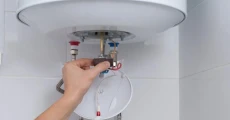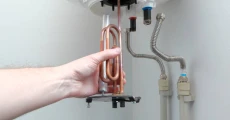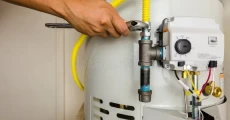How to Fix or Replace a Heating Element in a Water Heater?

A faulty heating element can disrupt the performance of your water heater, affecting hot water supply and efficiency. This guide provides essential steps to diagnose, fix, or replace a malfunctioning heating element, helping restore your water heater’s functionality and reliability.
How to Fix or Replace a Heating Element in a Water Heater?
A failing heating element can bring your water heater’s performance to a halt, leaving you with inconsistent or no hot water at all. This key component is responsible for heating the water in electric heaters, and over time, it can wear down due to sediment buildup, overheating, or regular usage. A faulty heating element not only affects your daily hot water needs but also impacts the efficiency and energy usage of your water heater.
Your fridge is a kitchen superstar as it keeps all your food fresh and drinks cold.
But does the fridge feel warm when you open it?
Is there water all over the floor?
Fridge issues are the worst!
Diagnosing a Faulty Heating Element
To confirm that the heating element is causing the problem, look for these signs:
- Inconsistent or no hot water: If the water temperature varies or stays cold, the heating element may be faulty.
- Higher energy bills: A failing heating element can force the heater to work harder, increasing energy costs.
- Unusual noises: Popping or hissing sounds from the tank could indicate a damaged heating element or sediment buildup.
Precautions Before Working on a Heating Element
When handling the heating element, safety is critical. Follow these steps for a safe repair:
- Turn off power: Shut off the power supply to the water heater at the circuit breaker to avoid electrical shock.
- Drain the tank: Attach a hose to the drain valve and empty the tank to prevent water from spilling during repair.
- Allow the heater to cool: Wait for the water inside to cool down to avoid burns.
Removing the Faulty Heating Element
Accessing the Heating Element
The heating element is typically located inside the water heater tank:
- Remove the access panel: Use a screwdriver to open the panel, exposing the element and wiring.
- Disconnect the wiring: Unscrew the terminals to detach the wires connected to the heating element.
- Unscrew the heating element: Use an element wrench to loosen and remove the faulty heating element from the tank.
Extracting the Heating Element
After disconnecting the wiring and screws, carefully remove the heating element from the tank, avoiding any damage to the tank interior.
Installing the New Heating Element
Inserting the New Element
- Position the element: Align the new heating element with the mounting hole in the tank.
- Tighten the element: Screw the element in firmly but avoid over-tightening, which can cause damage.
Reconnecting the Wiring
- Reattach the wires: Connect the wires to the terminals and ensure they are secured tightly.
- Replace the access panel: Close and secure the access panel once all connections are complete.
Restoring Power and Testing
Turn On the Power
- Restore power: Flip the circuit breaker back on to restore electricity to the water heater.
- Check for proper heating: Run a hot water faucet to verify that the water is heating up consistently.
Monitor for Leaks or Noises
- Inspect for leaks: Check around the heating element for any signs of water leakage.
- Listen for sounds: Ensure there are no unusual noises, which could indicate an installation issue.
Common Heating Element Issues and Quick Fixes
- Sediment buildup: Sediment can accumulate around the heating element, causing it to overheat. Regularly flush the tank to avoid this issue.
- Loose wiring: If the water heater still doesn’t heat, double-check that the wires are securely connected.
- Thermostat issues: Sometimes, a malfunctioning thermostat can mimic a heating element problem. Test the thermostat and replace it if needed.






When to Call the Professionals?
Replacing a heating element involves working with electricity, making it a potentially risky task. At CLT Appliance Repair, our skilled technicians can safely replace or repair your water heater’s heating element, ensuring consistent hot water and efficient operation.
If troubleshooting doesn’t solve the problem or you detect leaks or unusual noises, it’s best to contact us immediately for professional assistance on water heater repair charlotte nc.
FAQs
Heating elements typically last 6-10 years but may need replacement sooner if signs of malfunction appear.
While possible, replacing a heating element involves electrical work and is best handled by a professional to ensure safety.
Sediment buildup, overheating, and power surges can lead to heating element failure over time.
No, the heating element warms the water, while the thermostat controls the temperature setting.
Use a multimeter to check for continuity. If the multimeter shows no reading, the element needs replacement.
Don't let a malfunctioning Water Heater disrupt your daily life. Contact CLT Appliance Repair today at 704-606-9043 to schedule your Water Heater repair service.
We'll have your Water Heater back to optimal performance in no time!
Dryer Repair Charlotte NC | Washing Machine Repair Charlotte NC | Refrigerator Repair Charlotte NC | Microwave Oven Repair Charlotte NC | Freezer Repair Charlotte NC | Dryer Vent Cleaning Charlotte NC | Dishwasher Repair Charlotte NC | Cooktop Repair Charlotte NC | Stove Repair Charlotte NC | Charlotte Ice Maker Repair | Garbage Disposal Repair Charlotte NC | Plumbing Repair Charlotte NC | Water Heater Repair Charlotte NC
Admiral Appliance Repair | Amana Appliance Repair | Bosch Appliance Repair | Electrolux Appliance Repair | Frigidaire Appliance Repair | General Electric Appliance Repair | Haier Appliance Repair | Hotpoint Appliance Repair | Jenn-Air Appliance Repair | Kenmore Appliance Repair | KitchenAid Appliance Repair | LG Appliance Repair | Magic Chef Appliance Repair | MayTag Appliance Repair | Roper Appliance Repair | Samsung Appliance Repair | Speed Queen Appliance Repair | Whirlpool Appliance Repair | Dacor Appliance Repair | Viking Appliance Repair | Thermador Appliance Repair | Sub-Zero Appliance Repair | Wolf Appliance Repair | Monogram Appliance Repair | Bertazonni Appliance Repair | BlueStar Appliance Repair | Thor Appliance Repair | Miele Appliance Repair | Cafe Appliance Repair | GE Appliance Repair
Appliance Repair Indian Land SC | Appliance Repair Indian Trail NC | Appliance Repair Pineville NC | Appliance Repair Rock Hill SC | Appliance Repair Belmont NC | Appliance Repair Matthews NC | Appliance Repair Lancaster SC | Appliance Repair Cornelius NC | Appliance Repair Fort Mill SC | Appliance Repair Concord NC | Appliance Repair Denver NC | Appliance Repair Monroe NC | Appliance Repair Mooresville NC | Appliance Repair Harrisburg NC | Appliance Repair Lake Wylie SC | Appliance Repair Huntersville NC | Appliance Repair Kannapolis NC | Appliance Repair Mint Hill NC | Appliance Repair Waxhaw NC | Appliance Repair Troutman NC | Appliance Repair Davidson NC | Appliance Repair Gastonia NC | Appliance Repair Charlotte NC

